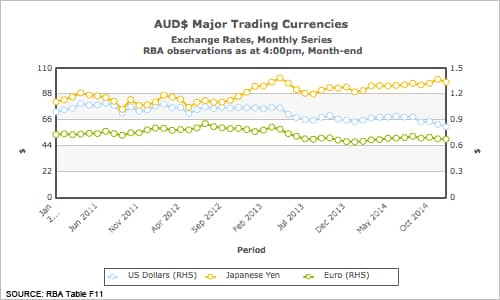The significant devaluation of the Euro evident during the post GFC period has assisted growth in European sawn softwood exports from 2008 to 2013 (see previous item).
However, it is instructive that the Euro strengthened against most currencies, to pre GFC levels over 2014. This was a period in which the volume of its imports to Australia grew and reached approximately 300,000 m3, while the total value of imports for the year-end November 2014 was a record AUD303.3 million.
Until mid January 2015, the Australian Dollar and Euro had traded relatively tightly for close to a year, with the Australian Dollar slipping back toward the end of the year, trading at EUR0.6746 at the end of December 2014.
The Australian Dollar exchange rate is displayed in the following chart from the FWPA Data Dashboard.
Fig 9

To go straight to the dashboard and take a closer look at the data, click here.
Depreciation of the Australian Dollar relative to the US Dollar has been widely remarked upon and is an important factor in trade.
However, it is the exchange rate with the Euro that is of greatest importance for many wood products. Underlying instability in the Euro was on display in mid-January when the Swiss National Bank altered its monetary policy unilaterally, as the next item describes.
The result was that almost overnight, the Euro depreciated sharply, as the next item discusses.



